By Gill Stephens and Alastair Govan
Note from editor: This article was submitted for inclusion in our journal Relative Matters. Unfortunately, it wasn't included due to a mistake on my part. Apologies to Gill and Alastair for this oversight. I hope you enjoy their write-up.
After possibly the wettest, most depressing autumn ever, we were amazed to find a forecast for clear, cold, calm weather coming along. We received a red alert for a Stacs trip on Friday 1st December, and travelled to Harris on Saturday 2nd. It’s quite hard to find accommodation in Harris in December, so most folks stayed in eye-wateringly expensive hotels or B&Bs. A lucky few found a very cost-effective static caravan to share, but it was freezing cold.
The original aim was a 2-day trip, but the forecast for Monday 4th became less favourable, so we aimed for a 1-day trip on Sunday 3rd. We departed Leverburgh just after 6, after a little confusion about the departure time being brought forward to 5.45. It was pitch black, gradually turning to dawn as we sailed. First impressions of St Kilda were that the tops of Hirta and Boreray was covered in frost, which was not a very promising sign.
As we got closer to Stac Lee, it was abundantly clear that conditions were not good. The rock was extremely wet and there was a great deal of green slime to contend with. It was obviously going to be a lot harder than the easy V. Diff that previous climbers have experienced. There was also more swell than expected.
Dave and Dan (from Skye Guides) went ashore to recce the route. They climbed all the pitches to the abseil boulder, wearing microspikes the whole way, then abseiled back down. It took them about 2 hours, which indicates just how hard it was. Dan likened it to winter mixed climbing in very thin conditions but without an ice axe, and Dave reckoned probably about VS.
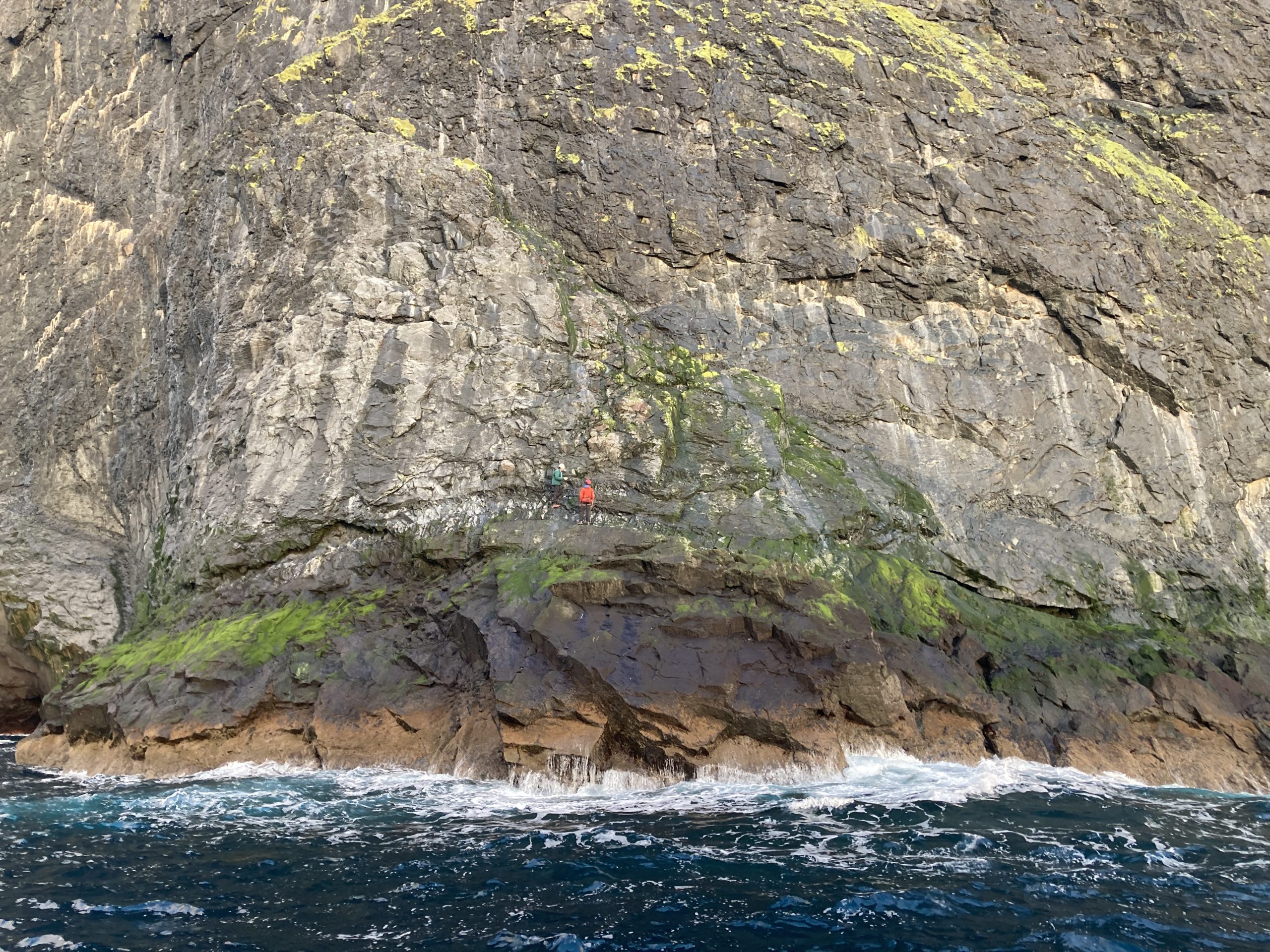
The step up from the landing area to the platform below the first pitch is short but undercut and slimy, so most will need a rope. Dan led a variant of the first pitch (first crux), since the traditional first pitch was a waterfall and lacked protection. The new line had incut holds and good gear. The second pitch is a leftwards traverse up an enclosed ramp (Zig). The exit onto the third pitch (a rightwards traverse; Zag) is also quite tricky, but the traverse is easy enough. The fourth pitch is the exit onto the upper ramp near the abseil point and forms a second crux.
There didn’t seem to be a secure abseil point above the exit pitch, because the boulders seem to have gone. Instead, there is a pile of boulders emerging from the ramp a few metres to the left, which gives a very secure anchor. Dave went down first, but had to stop and lock off several times to unravel ropes snagged on the ledges at various points down the face. The 60m ropes only just reached the platform below the first pitch and only when stretched.
Dave stayed on the Stac and Dan came back to boat, reporting that it was too difficult for his client, but that Dave would be able to take two people up the stac. Derek and Calum went ashore and Dave led them up the climb again, then the 3 of them went to the top, wearing microspikes all the way because it was very slippery.
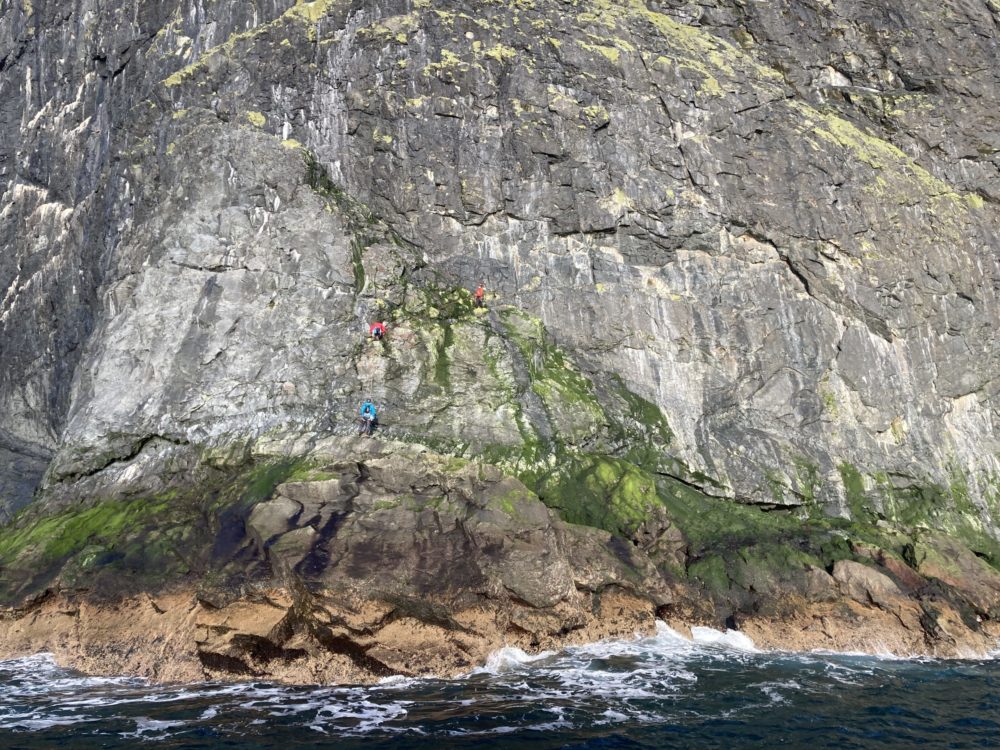
This is a pretty amazing achievement under the conditions. Congratulations and respect are due to all of them. All are grateful to Dan for his superb leads and route finding, making the climb possible.
Meanwhile, the rest of the group went to Stac an Armin. This was even greener and wetter than Stac Lee, but the showstopper was the tide, almost at its highest point by now. This meant that water was surging around the stack and creating a big swell, and the landing points were all underwater. The slabs below the stack curve steeply into the sea, which would make landing at high tide all but impossible at any time of year, even with low swell. There are also very few places where there are fault lines to provide climbable, protectable routes to get up to the top of the slabs and to start the traverse to the east side. The slabs themselves were completely covered in green slime, and it would have been difficult to provide rope protection for inexperienced or nervous climbers across the traverse.
It was still early in the day, and Dave and co. would likely be several more hours on Stac Lee, so Gill suggested that the rest of the group should go to Hirta and try to retrieve something from the day. At first, many were reluctant, having “bagged it already” but, in the end, everyone landed and had a walk. Gill climbed Conachair again, which was as lovely as ever and with the added bonus of the remains of a frost and frozen ground on the top. The sunset views over Dun were stunning. Dan climbed Oisebhal and everyone else wandered around Village Bay, exploring various buildings and chatting to researchers from St Andrews who were setting up cameras and other instruments to monitor sheep survival and grass availability during the winter.
Ian and Donald brought the boat back to collect us at about 3.45, with the 3 successful climbers aboard, then it was full steam ahead back to Leverburgh.
Many thanks to Ian and Donald for their superb boat handling skills and for the tea and ginger cake. Thanks also to Alastair and Rick Salter for organising the trip. It was enormously helpful having Dan along on the trip as a professional guide. As well as the initial recce with Dave, Dan suggested significant revisions to the risk assessment that are likely to be extremely helpful for future trips. And thanks to everyone on the trip for providing great company and good cheer in the face of adversity.
Conclusions
The take home message is that only the very best of climbers would be capable of making an ascent of Stac Lee in the winter months, given that microspikes were needed the whole way to the summit. It’s not for mere mortals. The difficulty is that the sea is warmer than the rock, so there’s a massive amount of condensation on the stacs. We did observe the rock beginning to dry when the sun got onto to it, but any improvement in conditions was marginal. Also, green slime and guano do not dry out except in prolonged warm weather, and the traverses, the upper ramp and the summit slopes were extremely slippery.
A second learning point is that Stac an Armin needs to be accessed at mid-low tide. The whole of the slab apron below the stac is very wet and green in winter, and the slippery conditions would make the traverse from west to east very difficult.
The third learning point is that the stacs are very intimidating. Stac Lee is an extremely serious place to be and there’s a lot of exposure on the climb. Mike Lates’ description grades the first and third pitches as 4a under the lovely dry conditions experienced in 2015, so it cannot be regarded as an easy climb, even though the difficulties are short-lived. Dave and Dan have shown that the difficulty increases dramatically under wet conditions. Even in summer, it will be very rare to have bone dry conditions matched with good enough sea conditions to make a landing.
Attendees
Derek Arnot, Bill Carr, Jonathan de Ferranti, Alastair Govan (trip coordinator), Peter Hastie, Calum Maclean, Dave McGimpsey, Dan Moss (Skye Guides), Gill Stephens, Simon Winton

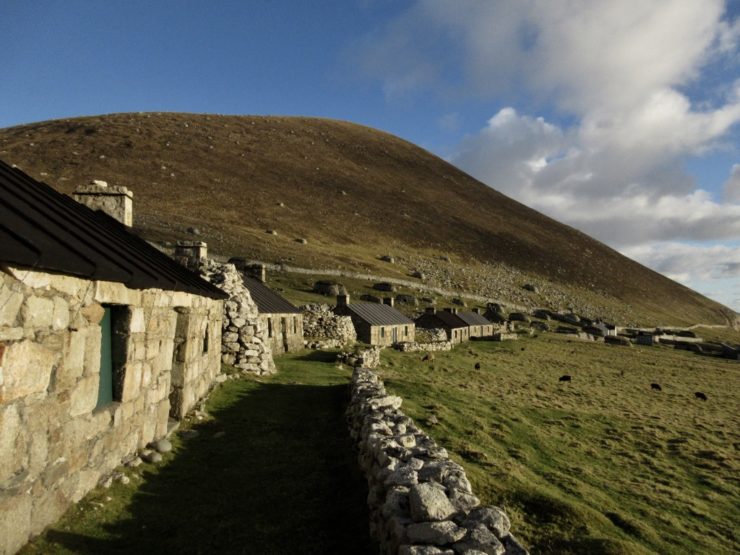
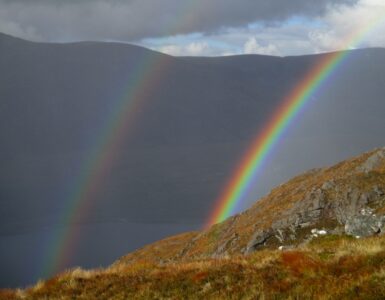
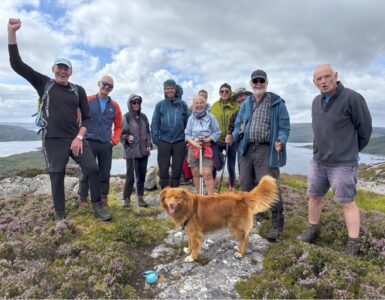
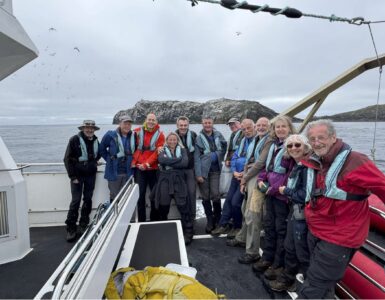
Add comment